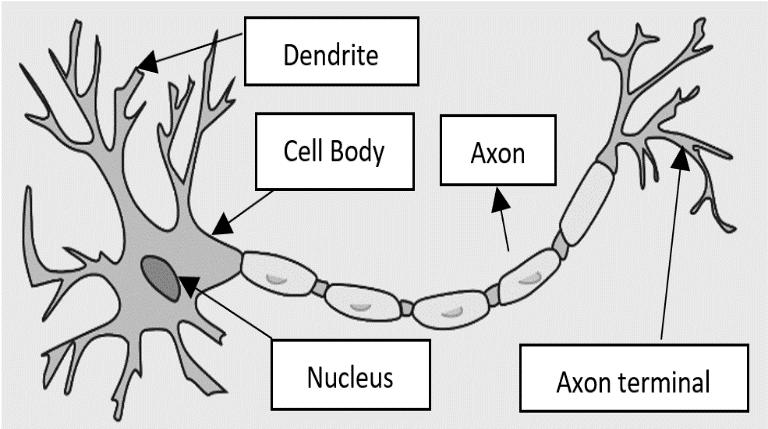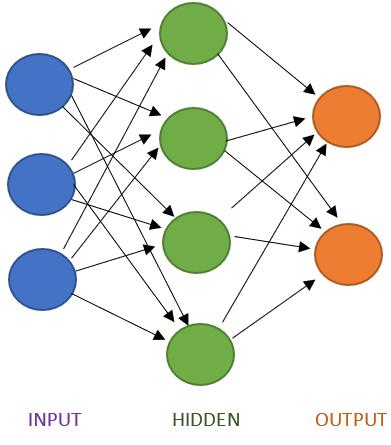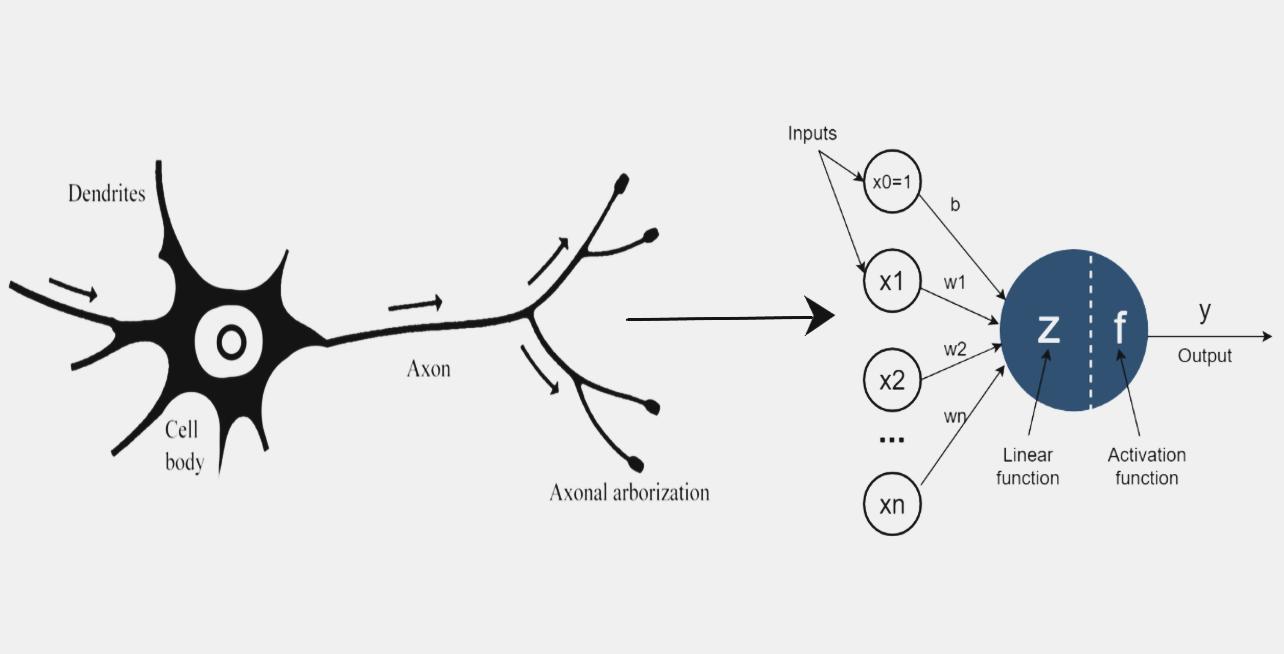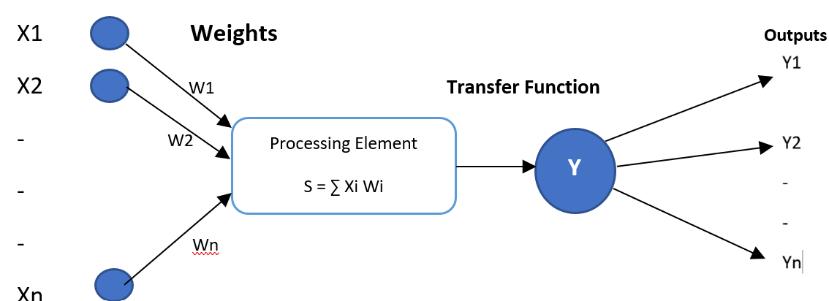Artificial Neural Network: A brief study
Mayuri Thorat1 , Shraddha V. Pandit2 , Supriya Balote3
1Student, Dept. of Artificial Intelligence and Machine Learning, PES’s Modern College Of Engineering, Pune, Maharashtra, India
2Associate Professor, Dept. of Artificial Intelligence and Data Science, PES’s Modern College Of Engineering, Pune, Maharashtra, India

3Assistant Professor, Dept. of Artificial Intelligence and Machine Learning, PES’s Modern College Of Engineering, Pune, Maharashtra, India ***
Abstract - An Artificial Neural Network (ANN) is a data processing paradigm inspired by the way biological nervous systems, such as the brain, process data. The unique structure of the information processing system is a crucialcomponent of this paradigm. It is made up of a huge number of highly interconnected processing elements (neurons) that work together to solve issues. ANNs, like humans, learn by example, and a huge dataset results in more accuracy. Through a learning process, an ANN is trained for a specific application, such as pattern recognition or data classification. This is also true of ANNs. This paper provides an overview of Artificial Neural Networks (ANN), their working, and training. It also describes the application and benefits of ANN.
Key Words: ANN (Artificial Neural Network), Neurons
1. INTRODUCTION
Apersonwhoknowshowtosolveaproblemcouldgivethe computerinstructionsonhowtosolvethatspecificproblem, sowefirstshouldknowtheanswertothatproblemorwe shouldknowhowtoovercometheproblemthatisinfrontof us. The computer follows a set of instructions to solve a problem, but without the specific steps that the computer needs to follow or know, the computer cannot assault the problem.Thislimitstheabilityofconventionalcomputersto solve problems to those that he already knows how to understand and solve. However, whatabout those issues? Whose response we are unsure of, hence networks were usedinsteadofourconventionalstrategyinthatsituation.
Inessence,neuralnetworksprocessinformationlikethatof thehumanbrain,andthesenetworkslearnfromexamples. They will learn from their experiences and from the examplestheyaregiven;youcannotprogramthemtocarry outacertaintask.ANNisprimarilymotivatedbyneurons, whicharenothingmorethanyourbraincellsandhowthe human brain functions [4]. A vast network of processing componentsmakesupourbrains.Thedrawbackisthatthe networksolvestheproblemonitsown.
A network of 10 billion neurons can be found in a typical brain. Axon: Output, Synaptic: Link, Cell body: Processor,
Dendrites:Input(asshowninfig1).Hereisadiagramofa neuron, which essentially shows how a biological neuron receivesinputfromothersources,combinesthatinputand thenperformsageneraloperation.Thisissimilartohowthe human brain learns from experience and examples. Dendritestrieswillreceivesignalsfromtheotherneurons, transfers them to the cell body, and the cell body will performsomefunction;thisfunctionmaybesummationor multiplication.Afterperformingthesetofinputsbyexam,it istransferredtothenext.Weaimtobuildanetworktodo thataswell.Anetworkof10billionneuronscanbefoundin a typical brain. Axon: Output, Synaptic: Link, Cell body: Processor, Dendrites: Input (as shown in fig 1). Here is a diagram of a neuron, which essentially shows how a biological neuron [4] receives input from other sources, combinesthatinputandthenperformsageneraloperation. This is similar to how the human brain learns from experienceandexamples.Dendritestrieswillreceivesignals fromtheotherneurons,transfersthemtothecellbody,and thecellbodywillperformsomefunction;thisfunctionmay besummationormultiplication.Afterperformingthesetof inputsbyexam,itistransferredtothenext.Weaimtobuild anetworktodothataswell.Weareinterestedindeveloping artificialneuralnetworks(ANNs)fortwoprimaryreasons:
Technicalviewpoint: Someissues,likecharacterrecognition orpredictingasystem'sfuturestates,callforhighlyparallel andadaptiveprocessing.
Biological viewpoint: ANNs can be used to recreate and model human (or animal) brain components, providing insight into natural information processing. ANN is a problem-solvingtechniquethatinvolvescreatingsoftware thatfunctionssimilarlytoourbrains.
1.1 What is ANN?
In essence, artificial neural networks are a class of computingsystemsdevelopedtoanalyzeandprocessdata likethatofthehumanbrain.Artificialneuralnetworkscan be tailored for a particular application and possess selflearning features that enable them to produce improved results as new data becomes available. The ability to translate websites into several languages, use virtual assistantstodoonlinegroceryorders,andidentifypatterns andclassifydataareallmadepossiblebyneuralnetworks. Artificial neural networks (ANNs) are computational networksthatarebiologicallyinspiredAsshowninFig.3. Artificialneuralnetworksareatechnologybasedonbrain and nervous system research. These networks mimic biologicalneuralnetworks,althoughtheyuseasubsetofthe principlesfoundinbiologicalbrainsystems.ANNmodels,in particular, imitate the electrical activity of the brain and nervoussystem.Processingelementscommunicatewithone another.Anartificialneuralnetworkismadeupofthreeor more interconnected layers. The first layer is made up of inputneurons.Thoseneuronssenddatatothedeeperlayers, whichdeliverthefinaloutputdatatothelastoutputlayer. Theinnerlayersareallhiddenandbuiltbyunitsthatchange the information received from layer to layer adaptively throughasequenceoftransformations.Eachlayerservesas both an input and output layer, allowing the ANN to comprehend more complicated things. These inner layers arereferredtocollectivelyastheneurallayer.Toarriveat solutions, ANN uses data samples rather than whole data sets, which saves both time and money. ANNs are simple mathematicalmodelsusedtoimproveexistingdataanalysis technology. A basic neural network is composed of three maincomponents:Aninputlayer,ahiddenlayer[5],andan outputlayerarecomponentsofanartificialneuralnetwork.

InputLayer:AlsoknownasInputNodes,thislayercontains the inputs/information from the outside world that the modelusestolearnanddrawconclusions.Inputnodessend datatothefollowinglayer,theHiddenlayer.
HiddenLayer:Ahiddenlayerisagroupofneuronsthatdo all computations on the input data [5]. There can be any numberofhiddenlayersinaneuralnetwork.Themostbasic networkhasasinglehiddenlayer
Output layer: The output layer contains the model's output/conclusions produced from all calculations. The outputlayercouldhaveoneormorenodes.
Advantages
• Adapttonewcircumstances
• Powerful,itcansimulateintricatefunctions
• Easytouse,learnbydoing,andrequiresrelatively littledomain-specificknowledgefromtheuser
Disadvantages
• Forgets
• Notexact
• Largecomplexityofthenetworkstructure
The model may generalize and forecast unseen data after learningfromtheinitialinputsandtheirassociations,aswell asfromunforeseenrelationshipsinferredfromunobserved data.


2. ADVANTAGES
1. A linear program cannot carry out tasks that a neuralnetworkcan.Duetoitsparallelproperties, theneuralnetworkcancontinuefunctioningeven whenoneofitscomponentsfalters.
2. After training, the system can generate output withoutrequiringcompleteinputs.
3. Since Neural Networks are made to make robots functionlikepeople,theyhaveseveraladvantages over human replacements and a wide range of applications.agriculture,mining,engineering,and otherfields.
4. ANN does not place any limitations on the input variables, in contrast to many other prediction algorithms.Learning,ratherthanprogramming,is usedtoconstructthesystem
5. ANNs can learn and model non-linear and complicated interactions, which iscrucial because many of the relationships between inputs and outputs in real-life situations are non-linear and complex.
6. Oneofthemanyadvantagesofneuralnetworksis their ability to multitask. The design of new, sophisticatedprogramsallowsthemtomultitask
7. Andproducemultipleeffects.Ataskthatcouldtake humanslongerhourstocompletecanbecompleted swiftlybyamachineifitisproperlyprogrammed.
8. Anyapplicationcanuseittoexecuteit.
9. Thecompletesoftwarebackupisaccessibleonlineif thehardwareisdamagedorfails.
10. Neuralnetworksmakedecisionsanddon'tneedto bereprogrammed[4].
3. APPLICATIONS
Withcountlessapplicationsbeingimplementedeveryday, various real-time applications of Artificial Neural Networksareasfollows.
1. HandwritingRecognition:Handwrittencharacters are transformed into digital characters that a computercanreadusingneuralnetworks.
2. StockExchangeprediction:Thestockexchangeis
3. TravellingIssuesofsalesprofessionals:Itdealswith determining the best route between cities in a specificregion.

4. Image compression: The goal of neural network datacompressionistoreplicatetheoriginalimage by storing, encrypting, and compressing it once again. we can use picture compression neural networkstoreducetheamountofourdata.
5. Function approximation: including time series predictionandmodelling.
6. Classification: including patterns and sequence recognition, novelty detection and sequential decision-making.
7. Data processing: including filtering, clustering blinds source separation and compression. (data mining,e-mailSpamfinding)
8. Monitoringoftheenvironment:ANNscanbeused toforecastnaturaloccurrencesincludingweather, airquality,andearthquakes.
9. Marketing: ANNs can be used in consumer segmentation and tailored advertising to forecast customer behavior and optimize marketing strategies.
10. Cybersecurity:Itcanbeutilizedfortaskslikevirus detection,intrusiondetection,andnetworktraffic analysisinthefieldofcybersecurity.
4. WORKING OF AN ANN

Artificialneuralnetworksarebuiltinthesamewayasthe humanbrainis,withneuronnodesconnectedinaweb-like pattern. The human brain is made up of billions of neurons. Each neuron is made up of a cell body that transportsinformationtoandfromthebrain.Theprimary principle behind such networks is inspired by how the human neural system processes data and information to learn and develop knowledge. The fundamental component of this concept is the development of new structures for the information processing system. The system is composed of a huge number of highly interconnectedprocessingcomponentsknownasneurons that collaborate to solve problems and communicate informationviasynapses(electromagneticconnections).
The neurons are tightly linked and grouped into layers. The data is received by the input layer, and the ultimate result is generated by the output layer. Typically, one or more secret layers are placed between the two. The number of hidden layers is determined by the application underconsideration.Theoutputoftheinputlayerbecomes theinputofthehiddenlayer,whiletheoutputofthehidden layer becomes the input of the output layer. This configurationmakesanticipatingorknowingtheprecise flowofdatachallenges.Inreal-timeapplications,thelayer ofinputneuronsreceivesdataeitherthroughinputfilesor directly from electrical sensors. The output layer sends
data to the outside world, a secondary computer operation, or other devices suchasa mechanical control system.Many hiddenlevels can exist betweenthesetwo layers.Manyneuronsarefoundintheseinternallayersin diverse interrelated systems. Each of these hidden neurons'inputsandoutputssimplygoestootherneurons. All artificial neural networks have a similar structure or topology as shown in Figure 4. In most networks, each neuroninahiddenlayergetssignalsfromallneuronsin the layer above it, which is often an input layer. After completingitsrole,aneuronsendsitsoutputtoallneurons in the layer below it, creating a feedforward path to the output.Theseroutesofcommunicationbetweenneurons are critical components of neural networks. They arethe connections that supply varying levels of strength to an input.Theselinksareclassifiedintotwosorts.Onecauses thefollowingneuron'ssummingmechanismtoadd,while theothercausesittoremove.Inhumanwords,oneexcites whiletheotherinhibits

Asshowninthefigure,wehavevariousinputs(X1,X2,...Xn) andcorrespondingweights[5](W1,W2,...Wn).Wecalculate theweightedsumofsomeoftheseinputsandthenpassthem through an activation function [5], which is nothing more thanathresholdvalue.
Threshold Value: The threshold value decides whether a neuronfiresornot.Abovethethresholdvalue,theneuron fires;otherwise,itdoesnotfire.Artificialneuralnetworksare madeupofalargenumberofartificialneurons,eachwithits activationfunction[1]andaprocessingelement Perceptron hastwomodes:trainingmodeandusingmode.
Trainingmode:Theneuroncanbeprogrammedtofireornot fireinresponsetospecificinputpatterns.
Usingmode:Whenataughtinputpatternisdetectedatthe input,therelatedoutputissettothecurrentoutput.
Wemustfirsttrainourperceptron,andonlythencanweuse it.Wegivemoreweighttomoresignificantfactorsandless weighttolessimportantfactors.WeightW1isassignedto inputX1,similarly,X2isassignedtoW2,andXnisassignedto Wn[3].
Example:X1,X2andX3aretheinputs.Weights=W1,W2, W3andThreshold=P
Calculation:O=X1
If P (Threshold Value) is greater than O, the neuron is activated.Eachlayerwillattempttoobtainamoreabstract versionoftheinput.
5. TRAINING AN ANN
When a network has been structured for a specific application,itisreadytobetrained.Theinitialweightsare picked at random to begin this process. The training, or learning, process then begins. Training methods are classified into three types: supervised, unsupervised, and ReinforcementTraining.Boththeinputsandtheoutputsare provided in supervised training. Unsupervised training

provides the network with inputs but not the expected outputs.Thesystemmustthenpickwhichfeatureswillbe used to group the supplied data. Supervised learning, Reinforcementlearning,andUnsupervisedlearningarethe threetypesofANNtraining.Therearesomedrawbacksto adopting supervised learning. These constraints can be bypassedbyemployingtheunsupervisedlearningtechnique.
A. Supervised Training [5].
The first type of training technique is supervised training. Where we are given both inputs and outputs. Backpropagation is the most often used algorithm for the supervisedtrainingofmulti-layerperceptron’s.Toreducethe error,wepropagatebackwardsandupdatetheweightsafter theweightedsumofinputsandtravelthroughtheactivation function.Theoutputisoftenreferredtoasthestopcondition. If our actual outcome matches the desired output, we can stopexecutingthealgorithm(wehavereachedourgoalstate ).Ifthereisadisparitybetweenthetargetandactualoutput, itisduetoanerrorfactor.Ifthefactorisdiscoveredusingthe formula[3],

Etotal=
We employ backpropagation [5] to reduce this error by modifyingweights(Byincreasinganddecreasingvaluesof weights). This is a trial-and-error strategy forachievinga zero-errorfactor.Itisthefastestlearningmechanismwith high accuracy Many different tasks, including as classification, regression, and sequence prediction, can be accomplishedbysupervisedlearning.Forinstance,inimage classification, an image serves as the input, and the label identifyingtheobjectorcategoryintheimageservesasthe output.Regressionproducescontinuousvalues,suchasthe priceofahousedependingonitscharacteristics.Insequence prediction, the network learns to foretell the following elementinachain,suchasthewordthatwillcomenextina sentence. For training, supervised learning needs a lot of labelleddata,whichcanbeexpensiveandtime-consumingto acquire. Nonetheless, it has been effective in a variety of applications, including computer vision, natural language processing,andspeechrecognition.
B. Unsupervised Training.
Unsupervised training is the second type of training. The networkisgiveninputsbutnotthedesiredoutputsduring unsupervised training. The system must then pick which features will be used to group the input data. It is an independentlearningprocesswhichrequiresnohelpfroma supervisorandcontains anunlabeleddataset.Itis usedto uncover hidden patterns. Autoencoders are one popular unsupervisedlearningmethodusedinANNtraining.Using neural networks, autoencoders can be trained to encode inputdataintoalower-dimensionalrepresentationandthen decodeittorestoretheoriginalspace.Inordertoreducethe
differencebetweentheinputandthereconstructedoutput, thenetworkistrained.Datacompression,featureextraction, and dimensionality reduction are all tasks that can be accomplished with autoencoders. Clustering is a typical unsupervisedlearningmethodusedinANNtraining.Based onasimilaritymetric,clusteringalgorithmscombinesimilar datapoints.Inunsupervisedlearning,thenetworklearnsto map input data points to the corresponding cluster labels using the output of clustering algorithms. Tasks including anomaly detection, categorization, and recommendation systems can be accomplished using this method. In ANN training,generativeadversarialnetworks(GANs)areanother well-liked unsupervised learning method. A generator network and a discriminator network make up GANs. The discriminator learns to discriminate between actual and createddata,whilethegeneratorlearnstoproducenewdata samplesthatmimictheinputdata.Thenetworksaretrained iterativelywiththegeneratortryingtotrickthediscriminator andthediscriminatortryingtoclassifythedataaccurately. BeforeANNsarefine-tunedwithsupervisedlearning,they canbepretrainedusingunsupervisedlearning.Bygivingthe network useful properties and lowering the amount of labelled data needed for training, pretraining can enhance networkperformance.
C. Reinforcement Training.
Thethirdtypeisreinforcementtraining,Itisalsocalledas Markovdecisionprocess.Itlearnsfromfeedbackandpast experiences. It is a long-term iterative process. The more feedback, the more accuracy. It is and combination of supervisedandunsupervisedtraining.Actor-critictrainingis apopulartechniqueforANNswithRL.Theperformerand the reviewer make up each of the two segments of the network in this strategy. The critic learns to estimate the value function, which is the predicted cumulative reward from a particular state, and the actor learns the policy. In ordertoupdatethepolicy,thevaluefunctionoffersfeedback ontheeffectivenessoftheactivitiesmade.Theactor-critic techniqueisaniterativeprocesswherethecriticchangesthe valuefunctionbasedontheobservedrewardsandtheactor adjuststhepolicybasedonfeedbackfromthecritic.Gradient descentisfrequentlyusedfortheupdates,andthegradients are calculated with consideration for the network's parameters
6. CONCLUSIONS
Inthispaper,wediscussedhowartificialneuralnetworks (ANNs) work, and also an ANN's training stages. ANN has severalbenefitsoverthetraditionalmethodandapplications ofANNs.Wemaysoonwitnessadditionaldevelopmentsin theuseofneuralnetworks,givenhowquicklybusinessesare adopting AI and machine learning at the moment. Users everywherewillhaveaccesstoawiderangeofcustomized optionsthankstoAIandmachinelearning.Neuralnetworks,
for instance, can enable the enhanced tailored experience thatallmobileandwebapplicationsstrivetoprovideyou with depending on your search history. Neurology and psychologyarealsotwofieldsofstudythatbenefitfromthe studyofneuralnetworks.Theyarefrequentlyemployedto examinetheinnerworkingsofthebrainandmodelcertain aspectsoflivingorganizations.Thetransferfunctions,sizeof the training sample, network topology, and weights adjusting technique are only a few examples of the many variablesthatdeterminehowwellANNsperform.
REFERENCES
[1]Lippmann,R.P.,1987.Anintroductiontocomputingwith neuralnets.IEEEAccost.SpeechSignalProcess.Mag.,April: 4-22.
[2]Nam Pham, Hao Yu, Bogdan M. Wilamowski, “Neural NetworkTrainerthroughComputerNetworks”,201024th IEEE International Conference on Advanced Information NetworkingandApplications.
[3] K Ishthaq Ahamed, Dr. Shaheda Akthar, “Survey on ArtificialNeuralNetworkLearningTechniqueAlgorithms”, International Journal of Imaging and Robotics, [Formerly knownasthe“InternationalResearchJournalofEngineering andTechnology(IRJET)Volume:03Issue:02|Feb-2016
[4]RozaDastres,MohsenSoori,“ArtificialNeuralNetwork Systems”, International Journal of Imaging and Robotics, [Formerlyknownasthe“InternationalJournalofImaging” (ISSN0974-0627)]Volume21;IssueNo.2;Year2021;Int.J. Imag.Robot.
[5] Dr S.Maheswari, “Neural network based individual classification system”, International Research Journal of EngineeringandTechnology(IRJET)Volume:03Issue:02| Feb-2016.

[6]Happiness Ugochi Dike,Yimin Zhou,Kranthi Kumar Deveerasetty,QingtianWu,“UnsupervisedLearningBased On Artificial Neural Network: A Review”, 2018 IEEE International Conference on Cyborg and Bionic Systems (CBS).
[7]Miguel Antonio Sovierzoski;Fernanda Isabel Marques Argoud;FernandoMendesdeAzevedo,“EvaluationofANN ClassifiersDuringSupervisedTrainingwithROCAnalysisand Cross Validation”, 2008 International Conference on BioMedicalEngineeringandInformatics
